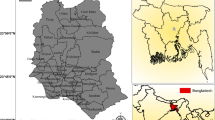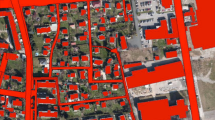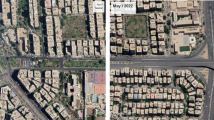Abstract
Pocket parks, the green infrastructures with small sizes and flexible layouts, are suitable for thermal environment improvement in the urban built-up block with limited green space. To quantify the relationship between pocket parks and the thermal environment in western China, two parks in the built-up block of Xi’an were selected. By field measurement, the cooling effect could be extended 100 m from the park boundary, connecting two parks. Furthermore, the road and greening within the block demonstrate significant influence on the cooling diffusion by regression analysis. Based on ENVI-met simulation, the ratio of the tree and the grass, the layout of the tree and the grass, and the layout of the paving were analyzed at different proportions of greening and paving of the park. Finally, a combination of the daytime physiological equivalent temperature (PET) and nighttime air temperature (AT) was proposed to choose the optimum layouts: the trees concentrated in the center and the pavement with more roads. Results can provide insights for designing pocket parks based on the thermal environment improvement.















Similar content being viewed by others
Data availability
The data and materials will be sent based on request.
References
Abd El Aziz NA (2015) Potentials of creating pocket parks in high density residential neighborhoods: the case of Rod El Farag, Cairo city. Int J Dev Sci 4(7):805–824
Amani-Beni M, Zhang B, Xu J (2018) Impact of urban park’s tree, grass and waterbody on microclimate in hot summer days: a case study of Olympic Park in Beijing, China. Urban Forest Urban Green 32:1–6
Aram F, García EH, Solgi E, Mansournia S (2019) Urban green space cooling effect in cities. Heliyon 5(4):e01339
Arellano Ramos B, Roca Cladera J, García Haro A (2020) Cooling effect of urban parks in the metropolitan region of Barcelona: the sample of Viladecans, Gavà and Castelldefels urban continuous. In Planning post carbon cities: 35th PLEA conference on passive and low energy architecture, A Coruña, 1st-3rd September 2020: proceedings (pp. 570–575). Universidade da Coruña
Armson D, Stringer P, Ennos AR (2012) The effect of tree shade and grass on surface and globe temperatures in an urban area. Urban Forest Urban Green 11(3):245–255
Brun P, Thuiller W, Chauvier Y, Pellissier L, Wüest RO, Wang Z, Zimmermann NE (2020) Model complexity affects species distribution projections under climate change. J Biogeogr 47(1):130–142
Chang CR, Li MH (2014) Effects of urban parks on the local urban thermal environment. Urban Forest Urban Green 13(4):672–681
Chang CR, Li MH, Chang SD (2007) A preliminary study on the local cool-island intensity of Taipei city parks. Landsc Urban Plan 80(4):386–395
Chen L, Ng E, An X, Ren C, Lee M, Wang U, He Z (2012) Sky view factor analysis of street canyons and its implications for daytime intra-urban air temperature differentials in high-rise, high-density urban areas of Hong Kong: a GIS-based simulation approach. Int J Climatol 32(1):121–136
Chen T, Lang W, Li X (2020a) Exploring the impact of urban green space on residents’ health in Guangzhou, China. J Urban Plann Dev 146(1):05019022
Chen X, Gao L, Xue P, Du J, Liu J (2020b) Investigation of outdoor thermal sensation and comfort evaluation methods in severe cold area. Sci Total Environ 749:141520
Cheng X, Wei B, Chen G, Li J, Song C (2015) Influence of park size and its surrounding urban landscape patterns on the park cooling effect. J Urban Plann Dev 141(3):A4014002
Cheung PK, Jim CY (2019a) Differential cooling effects of landscape parameters in humid-subtropical urban parks. Landsc Urban Plan 192:103651
Cheung PK, Jim CY (2019b) Effects of urban and landscape elements on air temperature in a high-density subtropical city. Build Environ 164:106362
Chibuike EM, Ibukun AO, Abbas A, Kunda JJ (2018) Assessment of green parks cooling effect on Abuja urban microclimate using geospatial techniques. Remote Sens Appl Soc Environ 11:11–21
Chow WT, Pope RL, Martin CA, Brazel AJ (2011) Observing and modeling the nocturnal park cool island of an arid city: horizontal and vertical impacts. Theor Appl Climatol 103(1):197–211
Cohen P, Potchter O, Matzarakis A (2012) Daily and seasonal climatic conditions of green urban open spaces in the Mediterranean climate and their impact on human comfort. Build Environ 51:285–295
Cohen P, Shashua-Bar L, Keller R, Gil-Ad R, Yaakov Y, Lukyanov V … Potchter O (2019) Urban outdoor thermal perception in hot arid Beer Sheva, Israel: methodological and gender aspects. Build Environ 160:106169
Doick KJ, Peace A, Hutchings TR (2014) The role of one large greenspace in mitigating London’s nocturnal urban heat island. Sci Total Environ 493:662–671
Du H, Cai Y, Zhou F et al (2019) Urban blue-green space planning based on thermal environment simulation: a case study of Shanghai, China. Ecol Ind 106:105501
Erell E, Pearlmutter D, Williamson T (2012) Urban microclimate: designing the spaces between buildings. Routledge, 2012
Envi-met, Basics of Envi-met model in, http://www.envi-met.com/. (Accessed 14 Aug 2020)
Evola G, Gagliano A, Fichera A, Marletta L, Martinico F, Nocera F, Pagano A (2017) UHI effects and strategies to improve outdoor thermal comfort in dense and old neighborhoods. Energy Procedia 134:692–701
Fan H, Yu Z, Yang G, Yiu Liu T, Ying Liu T, Huang CH, Vejre H (2019) How to cool hot-humid (Asian) cities with urban trees? An optimal landscape size perspective. Agri For Meteorol 265:338–348
Fang Z, Lin Z, Mak CM, Niu J, Tse KT (2018) Investigation into sensitivities of factors in outdoor thermal comfort indices. Build Environ 128:129–142
Feyisa GL, Dons K, Meilby H (2014) Efficiency of parks in mitigating urban heat island effect: an example from Addis Ababa. Landsc Urban Plan 123:87–95
Feng XG, Shi H (2012) Research on the cooling effect of Xi’an parks in summer based on remote sensing. Acta Ecol Sin 32(23):7355–7363
Georgakis C, Santamouris M (2017) Determination of the surface and canopy urban heat island in Athens central zone using advanced monitoring. Climate 5(4):97
Giridharan R, Lau SSY, Ganesan S, Givoni B (2008) Lowering the outdoor temperature in high-rise high-density residential developments of coastal Hong Kong: the vegetation influence. Build Environ 43(10):1583–1595
Gómez F et al (2011) Green areas, the most significant indicator of the sustainability of cities: research on their utility for urban planning. J Urban Plan Dev 137(3):311–328
Gou A, Li Y, Wang J (2021) Analysis of landscape microclimate and green space transformation strategy for old residential areas——case: Luoliu community. In E3S Web of Conferences (Vol. 271). EDP Sciences
Grilo F, Pinho P, Aleixo C, Catita C, Silva P, Lopes N, Branquinho C (2020) Using green to cool the grey: modelling the cooling effect of green spaces with a high spatial resolution. Sci Total Environ 724:138182
Gulyás Á, Unger J, Matzarakis A (2006) Assessment of the microclimatic and human comfort conditions in a complex urban environment: modelling and measurements. Build Environ 41(12):1713–1722
Gunawardena KR, Wells MJ, Kershaw T (2017) Utilising green and bluespace to mitigate urban heat island intensity. Sci Total Environ 584:1040–1055
Hamada S, Ohta T (2010) Seasonal variations in the cooling effect of urban green areas on surrounding urban areas. Urban Forest Urban Green 9(1):15–24
Heusinkveld BG, Steeneveld GV, Van Hove LWA, Jacobs CMJ, Holtslag AAM (2014) Spatial variability of the Rotterdam urban heat island as influenced by urban land use. J Geophys Res Atmos 119(2):677–692
Höppe P (1999) The physiological equivalent temperature–a universal index for the biometeorological assessment of the thermal environment. Int J Biometeorol 43(2):71–75
Irie T (2022) The cooling effect of green infrastructure in mitigating nocturnal urban heat islands: a case study of Yoyogi Park and Meiji Jingu Shrine in Tokyo. Landsc Res 47(5):559–583
Jin H, Liu Z, Jin Y, Kang J, Liu J (2017) The effects of residential area building layout on outdoor wind environment at the pedestrian level in severe cold regions of China. Sustainability 9(12):2310
Kalnay E, Cai M (2003) Impact of urbanization and land-use change on climate. Nature 423(6939):528
Konarska J, Holmer B, Lindberg F, Thorsson S (2016) Influence of vegetation and building geometry on the spatial variations of air temperature and cooling rates in a high-latitude city. Int J Climatol 36(5):2379–2395
Koudouna D, Economou A (2020) “‘Pocket parks’–role and benefits of their creation and contribution to the environmental upgrading of big cities.” 1st International Conference on Environmental Design (ICED), Greece, 311–317
Lam KC, Ng SL, Hui WC et al (2005) Environmental quality of urban parks and open spaces in Hong Kong. Environ Monit Assess 111(1–3):55–73
Lee LSH, Jim CY (2018) Thermal-cooling performance of subtropical green roof with deep substrate and woodland vegetation. Ecol Eng 119(April):8–18
Li H, Harvey J, Kendall A (2013) Field measurement of albedo for different land cover materials and effects on thermal performance. Build Environ 59:536–546
Li H, Sodoudi S, Liu J et al (2020a) Temporal variation of urban aerosol pollution island and its relationship with urban heat island. Atmos Res 241:104957
Li H, Wang G, Tian G, Jombach S (2020b) Mapping and analyzing the park cooling effect on urban heat island in an expanding city: a case study in Zhengzhou City, China. Land 9(2):57
Lin BS, Lin CT (2016) Preliminary study of the influence of the spatial arrangement of urban parks on local temperature reduction. Urban Forest Urban Green 20:348–357
Lin TP, Matzarakis A, Hwang RL (2010) Shading effect on long-term outdoor thermal comfort. Build Environ 45(1):213–221
Lin P, Lau SS, Qin H et al (2017) Effects of urban planning indicators on urban heat island: a case study of pocket parks in high-rise high-density environment. Landsc Urban Plan 168:48–60
Lü Y, Zhang L, Feng X, Zeng Y, Fu B, Yao X, Wu B (2015) Recent ecological transitions in China: greening, browning and influential factors. Sci Rep 5(1):1–8
Lu J, Li Q, Zeng L, Chen J, Liu G, Li Y, Li W, Huang K (2017) A micro-climatic study on cooling effect of an urban park in a hot and humid climate. Sustain Cities Soc 32:513–522
Matzarakis A, Rutz F, Mayer H (2007) Modelling radiation fluxes in simple and complex environments—application of the RayMan model. Int J Biometeorol 51(4):323–334
Motazedian A, Coutts AM, Tapper NJ (2020) The microclimatic interaction of a small urban park in central Melbourne with its surrounding urban environment during heat events. Urban Forest Urban Green 52:126688
Monteiro MV, Doick KJ, Handley P, Peace A (2016) The impact of greenspace size on the extent of local nocturnal air temperature cooling in London. Urban Forest Urban Green 16:160–169
Oke TR (1982) The energetic basis of the urban heat island. Q J R Meteorol Soc 108(455):1–24
Oke TR (2004) Initial guidance to obtain representative meteorological observations at urban sites. IOM Report 81, World Meteorological Organization, Geneva
Oliveira S, Andrade H, Vaz T (2011) The cooling effect of green spaces as a contribution to the mitigation of urban heat: a case study in Lisbon. Build Environ 46(11):2186–2194
Onishi A, Cao X, Ito T, Shi F, Imura H (2010) Evaluating the potential for urban heat-island mitigation by greening parking lots. Urban Forest Urban Green 9(4):323–332
Peng C, Ming T, Tao Y et al (2015) Numerical analysis on the thermal environment of an old city district during urban renewal. Energy Build 89:18–31
Peng J, Dan Y, Qiao R, Liu Y, Dong J, Wu J (2021) How to quantify the cooling effect of urban parks? Linking maximum and accumulation perspectives. Remote Sens Environ 252:112135
Peschardt KK, Stigsdotter UK (2013) Associations between park characteristics and perceived restorativeness of small public urban green spaces. Landsc Urban Plan 112:26–39
Petralli M, Massetti L, Brandani G, Orlandini S (2014) Urban planning indicators: useful tools to measure the effect of urbanization and vegetation on summer air temperatures. Int J Climatol 34(4):1236–1244
Potchter O, Cohen P, Bitan A (2006) Climatic behavior of various urban parks during hot and humid summer in the Mediterranean city of Tel Aviv, Israel. Int J Climatol 26(12):1695–1711
Qiu K, Jia B (2020) The roles of landscape both inside the park and the surroundings in park cooling effect. Sustain Cities Soc 52:101864
Ren Z, He X, Zheng H, Zhang D, Yu X, Shen G, Guo R (2013) Estimation of the relationship between urban park characteristics and park cool island intensity by remote sensing data and field measurement. Forests 4(4):868–886
Shaeri J, Aflaki A, Yaghoubi M, Janalizadeh H (2018) Investigation of passive design strategies in a traditional urban neighborhood: a case study. Urban Climate 26:31–50
Shi D, Song J, Huang J, Zhuang C, Guo R, Gao Y (2020) Synergistic cooling effects (SCEs) of urban green-blue spaces on local thermal environment: a case study in Chongqing China. Sustain Cities Soc 55:102065
Shih W (2017) Greenspace patterns and the mitigation of land surface temperature in Taipei metropolis. Habitat Int 60:69–80
Simon H, Lindén J, Hoffmann D et al (2018) Modeling transpiration and leaf temperature of urban trees–a case study evaluating the microclimate model ENVI-met against measurement data. Landsc Urban Plan 174:33–40
Spronken-Smith RA, Oke TR (1998) The thermal regime of urban parks in two cities with different summer climates. Int J Remote Sens 19(11):2085–2104
Taleghani M, Sailor D, Ban-Weiss GA (2016) Micrometeorological simulations to predict the impacts of heat mitigation strategies on pedestrian thermal comfort in a Los Angeles neighborhood. Environ Res Lett 11(2):024003
Toparlar Y, Blocken B, Maiheu BV, Van Heijst GJF (2018) The effect of an urban park on the microclimate in its vicinity: a case study for Antwerp, Belgium. Int J Climatol 38:e303–e322
Vellei M, Herrera M, Fosas D et al (2017) The influence of relative humidity on adaptive thermal comfort. Build Environ 124:171–185
Vieira J, Matos P, Mexia T, Silva P, Lopes N, Freitas C, Pinho P (2018) Green spaces are not all the same for the provision of air purification and climate regulation services: the case of urban parks. Environ Res 160:306–313
Wang Y (2019) Pocket park design from the perspective of low-carbon Ecology: inspiration from New York’s 2015 master plan. China Acad J Electron Publ House 593–600. https://doi.org/10.26914/c.cnkihy.2019.004363. (in Chinese)
Wang Y, Akbari H (2014) Effect of sky view factor on outdoor temperature and comfort in Montreal. Environ Eng Sci 31(6):272–287
Wang Y, Akbari H (2017) Urban heat island and mitigation solutions evaluation in cold climates: a case of Montreal. Adv Environ Res 54:143–177
Wang X, Cheng H, Xi J, Yang G, Zhao Y (2018) Relationship between park composition, vegetation characteristics and cool island effect. Sustainability 10(3):587
Wong NH, Yu C (2005) Study of green areas and urban heat island in a tropical city. Habitat Int 29(3):547–558
Wu C, Li J, Wang C, Song C, Haase D, Breuste J, Finka M (2021) Estimating the cooling effect of pocket green space in high density urban areas in Shanghai, China. Front Environ Sci 9:657969
Xi’an Government (2019) Notice of Xi’an City Management Committee Office on issuing the construction tasks of green space plaza and theme park in 2019, http://xacg.xa.gov.cn/zwgk/zfwj/bmwj/jfw/5d7108bffd8508123e9190b6.html. (Accessed 9 October 2020)
Xie Y, Huang T, Li J et al (2018) Evaluation of a multi-nodal thermal regulation model for assessment of outdoor thermal comfort: sensitivity to wind speed and solar radiation. Build Environ 132:45–56
Yan H, Wu F, Dong L (2018) Influence of a large urban park on the local urban thermal environment. Sci Total Environ 622:882–891
Yang Y, Chen R, Han C, Liu Z (2021) Evaluation of 18 models for calculating potential evapotranspiration in different climatic zones of China. Agri Water Manag 244:106545
Yu H, Jiang S, Land KC (2015) Multicollinearity in hierarchical linear models. Soc Sci Res 53:118–136
Yu Z, Xu S, Zhang Y, Jørgensen G, Vejre H (2018) Strong contributions of local background climate to the cooling effect of urban green vegetation. Sci Rep 8:6798
Yu Z, Chen S, Wong NH, Ignatius M, Deng J, He Y, Hii DJC (2020) Dependence between urban morphology and outdoor air temperature: a tropical campus study using random forests algorithm. Sustain Cities Soc 61:102200
Yu H, Fukuda H, Zhou M, Ma X (2022) Improvement strategies for microclimate and thermal comfort for urban squares: a case of a cold climate area in China. Buildings 12(7):944
Zhang H, Han M (2021) Pocket parks in English and Chinese literature: a review. Urban For Urban Green 61:127080
Zhang Y, Lin Z, Fang Z, Zheng Z (2022) An improved algorithm of thermal index models based on ENVI-met. Urban Climate 44:101190
Acknowledgements
This research is supported by the Young Scientists Fund of the National Natural Science Foundation of China (Grant No. 51608439), the Fund of the National Natural Science Foundation of China (Grant No. 52078416), and the Shaanxi Provincial Land Engineering Construction Group, China under grant 201912131-A5.
Author information
Authors and Affiliations
Contributions
Dixuan Ma carried out field measurements and ran simulations, analyzed the results, and wrote the manuscript; Dian Zhou and Yupeng Wang designed the experiments and guided the writing; Zongzhou Zhu participated in field measurements and revised the manuscript.
Corresponding author
Ethics declarations
Ethics approval
We followed the accepted principles of ethical and professional conduct.
Consent to participate
All the authors agreed to participate in the paper.
Consent for publication
All the authors have read and approved the manuscript for publication.
Competing interests
The authors declare no competing interests.
Additional information
Responsible Editor: Robert Duran
Publisher's note
Springer Nature remains neutral with regard to jurisdictional claims in published maps and institutional affiliations.
Rights and permissions
Springer Nature or its licensor (e.g. a society or other partner) holds exclusive rights to this article under a publishing agreement with the author(s) or other rightsholder(s); author self-archiving of the accepted manuscript version of this article is solely governed by the terms of such publishing agreement and applicable law.
About this article
Cite this article
Ma, D., Wang, Y., Zhou, D. et al. Cooling effect of the pocket park in the built-up block of a city: a case study in Xi’an, China. Environ Sci Pollut Res 30, 23135–23154 (2023). https://doi.org/10.1007/s11356-022-23809-9
Received:
Accepted:
Published:
Issue Date:
DOI: https://doi.org/10.1007/s11356-022-23809-9




